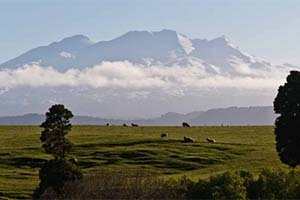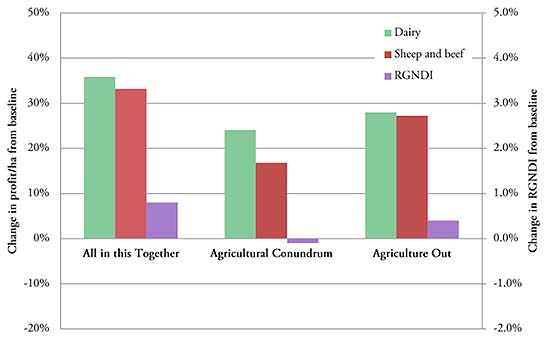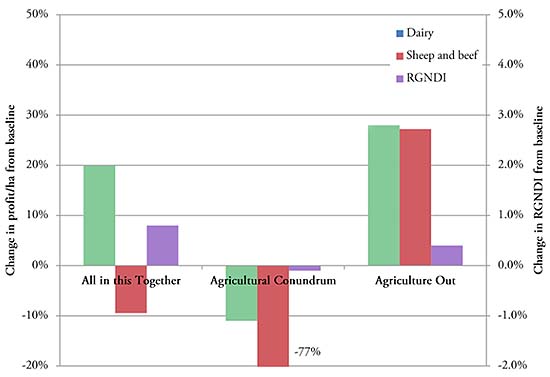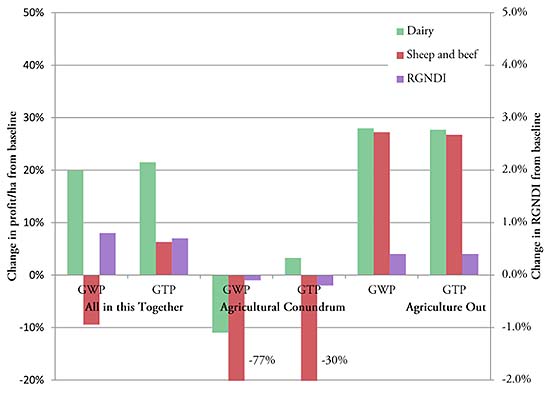
By Zack Dorner and Suzi Kerr*


In NZ, 48% of greenhouse gas emissions are from agriculture: methane (30%) and nitrous oxide (18%). This is a very high proportion compared with the rest of the developed world.
Recent modelling has shown that an effective global climate policy for agriculture would help NZ economically, as effective global mitigation for agriculture will lower the global costs of limiting warming to 2 degrees.
It will also raise commodity prices for dairy and meat, which provides benefits for our farmers.
In this paper we extend this modelling to evaluate the impact of global climate policy scenarios on NZ farmers.
Scenarios
We use three different scenarios for 2020 from Stroombergen and Reisinger’s work to consider the implications for NZ of whether agricultural emissions are included in global climate policy.
Table 1: Summary of the scenarios for 2020 from Stroombergen and Reisinger.
| Scenario | Global policy | NZ policy |
| All in this Together | All emissions, including agriculture, face the same price. | All emissions priced at global price; agriculture only pay for 10% of their emissions in 2015, increasing by 1.3% per year. NZ responsible for all types of emissions in mitigation target of 15% below 1990 levels by 2020. |
| Agricultural Conundrum | All emissions are priced except agricultural emissions, but countries are still accountable for those emissions. | As above. |
| Agriculture Out | All emissions are priced except agricultural emissions, and countries are not accountable for those emissions. | All emissions are priced at the global price except agricultural emissions. NZ is responsible for all emissions in mitigation target of 15% below 1990 levels by 2020, except agriculture. |
| Baseline | No emissions are priced (for comparison only - no damages from climate change are modelled). | |
Implications for New Zealand farmers
We extend Stroombergen and Reisinger’s modelling by considering the impact of their scenarios on farm profits. To do this, we develop two model farms – one dairy and one sheep and beef.
We put a 10% and 100% liability on the farms’ non-CO2 emissions and use the GWP metric (see below). We assume no mitigation by NZ farms, though in reality farmers do have mitigation options available. For all scenarios we put a 100% liability on CO2 emissions and compare with Stroombergen and Reisinger’s results for NZ’s change in real gross national disposable income (RGNDI) from baseline.
Figure 1 Farm change in profit/ha compared with baseline at 10% liability for agricultural emissions in 2020 alongside NZ’s change in RGNDI

How farm profits are affected by the three scenarios depends critically on global climate policy for agriculture and the level of liability NZ farmers face for their emissions.
• Excluding agricultural emissions from global climate policy (Agricultural Conundrum and Agriculture Out) increases the global CO2 price significantly. This raises livestock commodity prices (dairy and meat) by 14% in 2020 because less agricultural land is available globally as there is more competition from forests.
• On the other hand, pricing global agricultural emissions (All in this Together) lowers the global CO2 price, but leads to an additional 4% increase in livestock commodity prices in 2020.
• When facing a 10% liability on their non-CO2 emissions, NZ farmers prefer All in this Together, given it has the highest livestock commodity prices and emission costs are small as a percentage of profit under all three scenarios.
Figure 2 Change in profit/ha compared with baseline of the farms with all emissions at 100% liability in 2020 alongside NZ’s change in RGNDI

Across the scenarios that meet the global target, New Zealand benefits most in the All in this Together scenario as do New Zealand farmers under the previously proposed emissions trading scheme (ETS) rules – with farmers initially facing only 10% of the emissions price. However, despite the higher livestock commodity prices in All in this Together, New Zealand farmers slightly prefer Agriculture Out if they face a 100% emission liability. Livestock commodity prices do not rise enough to match the higher costs with an emission liability and farmers do not benefit much from the lower CO2 price. The worst outcome for both New Zealand and New Zealand farmers is if we are responsible for agricultural emissions but other countries do not act to mitigate them.
Metrics
Metrics allow the trading off of mitigation of one type of GHG against another in order to mitigate climate change at least cost. The most common metrics are Global Warming Potential (GWP) and Global Temperature Change Potential (GTP). GWP reflects the effectiveness of different types of greenhouse gases (GHGs) at retaining heat energy in the atmosphere over a period of time. GTP, however, measures the global temperature change in an individual future year due to the emission now of a GHG, relative to CO2. An analogy is to think of installing insulation into one of two identical houses with identical heaters at identical settings.
GWP is like measuring the difference in average amount of heat energy trapped in the two houses over 100 minutes, while GTP is like comparing the temperature difference between the two houses in 100 minutes time.
Methane emissions are quite sensitive to which metric is chosen as an exchange rate between GHGs. GWP with a time horizon of 100 years has been adopted as the standard climate change metric under the UNFCCC. GWP now assigns methane a value of 28 times CO2 whereas GTP assigns methane a value of just 7 times CO2 for the same 100-year time horizon. This has little effect on New Zealand’s preferences but a large effect on what scenario farmers will prefer.
Implications of metrics for farmers
Below, we consider the implications of metrics under the scenarios for farmers. We look only at 100% liability for all emissions as the differences between metrics are negligible for farmers facing a 10% liability on their non-CO2 emissions.
Figure 3. Change in profit/ha compared with baseline of the farms with all emissions at 100% liability in 2020 alongside NZ’s change in RGNDI

Figure 3 shows the GTP metric is better for NZ farmers than GWP simply because they would face a lower emissions cost. While GTP leads to higher global CO2 prices and lower livestock prices, the fact that it puts much lower weight on methane relative to CO2 , more than offsets the differences. This contrasts with the impact on NZ’s real gross national disposable income, for which GWP is always slightly preferred due to the lower global CO2 prices.
Overall though, which policy scenario is still more important than which metric is chosen, even for farmers.
Conclusion
The ability of NZ’s agricultural sector to mitigate and bear some of the costs of their GHGs is important if agricultural emissions continue to be included in our national mitigation targets. Recent dairy prices illustrate that farmers face volatile international commodity prices and our modelling suggests that farmers may see much larger gains or losses from international climate policy than the country as a whole. However, effective global climate policy on agriculture could lead to higher commodity prices for NZ’s farmers. Government must therefore be mindful of these factors when deciding how large an emissions liability individual farms can bear.
Our modelling shows little difference between All in this Together and Agriculture Out for farmers. This is a striking result in itself given the difference in emission costs faced by farmers between the two scenarios and demonstrates the efficiency of the NZ farming sector. As expected our results show that (like NZ as a whole) farmers also want to avoid the Agricultural Conundrum, though this is the closest scenario to current global climate policy. Outside of that scenario, our modelling suggests farmers have a preference for the GTP metric over the GWP (assuming they undertake no mitigation), but the difference is not as large as the difference between overall scenarios.
NZ should be pushing for other countries to include agricultural emissions in their national climate policies as this lowers global costs for mitigating climate change and favours our efficient farmers. NZ can then continue to focus on our role as one of the most efficient livestock producers in the world, and help others to become more efficient too.
---
Zack Dorner is a PhD candidate in economics at Monash University. He was a Green Party candidate in the 2011 election. Suzi Kerr is a Senior Fellow at Motu and an Adjunct Professor at Victoria University. This work was done as part of the “Coordination and Cooperation for Effective Climate Policy Design and Implementation” programme funded by the Ministry for Primary Industries Sustainable Land Management and Climate Change Fund by Motu Economic and Public Policy Research.
We welcome your comments below. If you are not already registered, please register to comment
Remember we welcome robust, respectful and insightful debate. We don't welcome abusive or defamatory comments and will de-register those repeatedly making such comments. Our current comment policy is here.